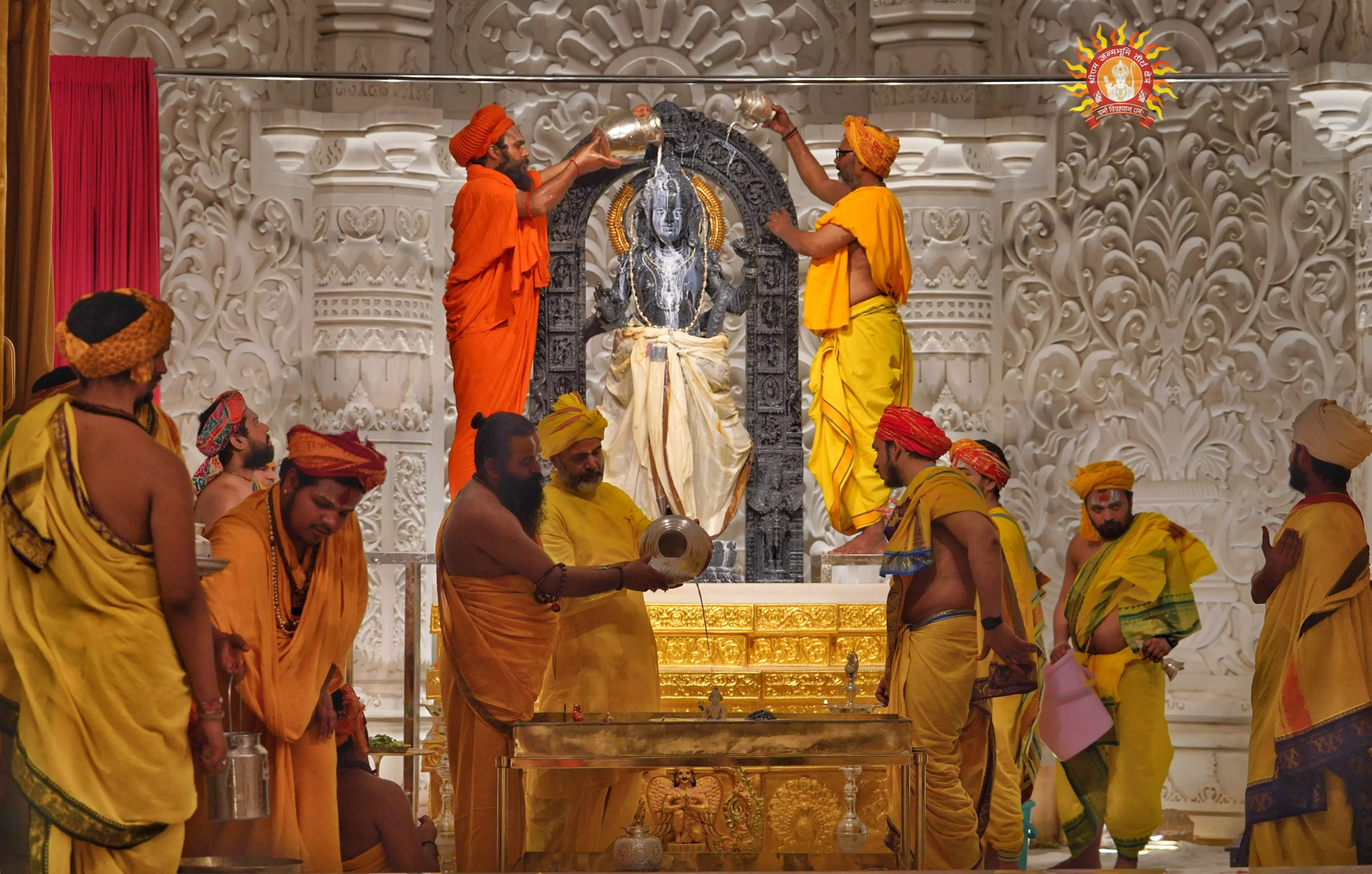
The science and tradition behind Ram Lalla’s 'Surya Tilak' on Ram Navami
The highly-anticipated ‘Surya Tilak’ of Ram Lalla unfolded around noon for three minutes, as part of the Ram Navami celebrations at Ayodhya's new Ram Mandir

n a sheer blend of science and tradition, the highly-anticipated celestial event, the ‘Surya Abhishek’ of Ram Lalla grandly unfolded today around noon for three minutes, as part of the Ram Navami celebrations at the Ayodhya Ram Mandir.
Using cutting-edge scientific expertise, a 5.8 centimetre beam of light hit the deity's forehead. For three minutes, the Sun's rays shone brightly on Lord Ram's forehead forming a 75 mm ‘tilak’. This Surya Tilak, which will be performed every year at the Ram Mandir, marks a significant auspicious moment for Ram devotees from across the world as they watch the Sun's rays kiss the forehead of Ram Lalla.
It is also significant because Lord Ram is from the Ishvaku clan, believed to be the descendents of the Sun, or Suryavanshis.
The atmosphere in the temple was electric as thousands of devotees thronged Ayodhya's Ram Temple to witness the event. The temple was beautifully decked up to welcome devotees on the first Ram Navami after its grand opening.
The entire temple complex has been illuminated with colourful lights. A red carpet has been laid on the Janmabhoomi Path to facilitate the movement of devotees under the scorching sun. As many as 56 types of bhog prasad are to be offered to Ram Lalla.
What is Surya Abhishek?
Surya Abhishek or Tilak is actually a mix of optics and mechanics at play, where the sun's rays are made to fall on the deity's forehead, as a symbol of reverence.
Scientists from the Indian Institute of Technology, Roorkee, (IIT-R) were roped in to calculate the timings and work out the Surya Tilak mechanism to illuminate the Ram Lalla’s forehead at the Ayodhya temple.
According to the Sri Ram Janmabhoomi Teerth Kshetra Trust, the ‘Surya Abhishek’ of Ram Lalla was performed using an optomechanical system with high-quality mirrors and lenses.
The Sun’s rays initially fell on a mirror installed on the temple’s top floor, then with the help of three lenses, they were directed to another mirror on the temple’s second floor before reaching the sanctum-sanctorum of the temple to fall on Ram Lalla’s forehead.
While the Surya Abhishek in Ayodhya deploys lenses and mirrors to guide the Sun's rays to shine on Ram Lalla's forehead, ancient Indian temples have traditionally incorporated astronomically calculated openings in and around the garbhagriha (sanctum sanctorum) to allow sunlight to directly illuminate the deity on specific days.
Experts from the Central Building Research Institute (CBRI), Roorkee, set upcamping in Ayodhya to ensure the success of the ‘Surya Abhishek’. The director of CBRI, Roorkee, Prof Pradeep Kumar Ramancharla, and Prof Devdutt Ghosh were overseeing the entire Surya Abhishek project.
Incomparable bliss, says Modi
Meanwhile, Prime Minister Narendra Modi greeting people on Ram Navami day said Ayodhya is in "incomparable bliss" as this is the first time the festival will be celebrated there after the consecration of the Ram temple. “Ayodhya is in incomparable bliss as this is the first time the festival will be celebrated there after the consecration of the Ram temple,” reiterated PM Modi.
"The first Ram Navami after the Pran Pratishtha in Ayodhya is a generational milestone, weaving together centuries of devotion with a new era of hope and progress. This is a day crores of Indians waited for," Modi said in a series of posts on X.
This is the fruit of the hard work and sacrifices made by the people of the country over many years, he said.
Modi added, "May the blessings of Prabhu Shri Ram always remain upon us and guide our paths towards righteousness and peace, illuminating our lives with wisdom and courage." He said he feels overwhelmed and grateful on this occasion as he along with a large number of people in the country witnessed Ayodhya's consecration ceremony.
Further, Modi said, “Lord Ram is deeply embedded in the hearts of Indians. Ram Navami is also a time to remember and respect those saints and devotees who dedicated their lives to the construction of the temple in Ayodhya."
"I am confident that Maryada Purushottam Bhagwan Ram's life and ideals will become a strong basis for constructing 'Viksit Bharat'. His blessings will provide new energy to the resolve of 'Aatmanirbhar Bharat'," the PM added.
Surya Abhishek a common ritual in some temples in India
The Surya Abhishek is not new in India. The ritual has been a norm in several Jain temples and Hindu sun temples across India. Ancient Indian temples traditionally incorporated astronomically calculated openings in and around the sanctum sanctorum to allow sunlight to directly illuminate the deity on specific days, combining tradition with technology.
For example, the Suriyanar Kovil temple in Tamil Nadu is designed in such a way that sunlight aligns with specific points in the temple at certain times in a year, illuminating the deity, Suriyanar (Sun).
The Mahalaxmi temple in Kolhapur in Maharashtra, Modhera Sun temple in Gujarat, Ranakpur Jain temple in Rajasthan and many others are built in such a way that the sun's rays directly falls on the idol on certain days in a year.

